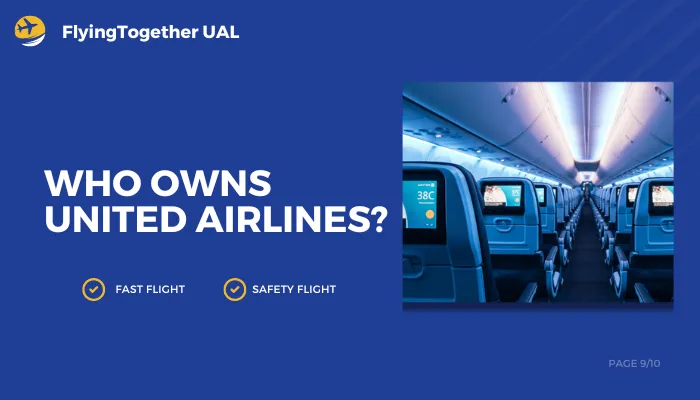These enormous planes, with their tails adorned by an iconic blue globe, fly across continents transporting millions of passengers annually. But Who Owns United Airlines? whose colossal operation this is?
Understanding the ownership structure of a major airline is important because it gives an insight into how decisions are reached, who influences them and where the company is heading.

Who is in Control of United Airlines?
United Airlines has a rich history that intertwines with its ownership. Let us take a walk down memory lane:
- Origins (1920s): United Airlines came about as a result of various small airlines merging under United Aircraft and Transport Corporation which was then merged with others. The consolidation meant that during those days, control was spread among different entities.
- Evolution Through Mergers (Mid-20th Century): Through strategic acquisitions especially after acquiring Capital Airlines in 1966, United Airlines increased its presence significantly. These mergers remodelled the ownership landscape resulting in control being transferred from one person to another.
- The Modern Era (Late 20th Century – Present): There were several mergers in the airline industry during the late 20th century. Later on, UNITED merged with Continental Airlines in 2010 thus creating a new parent company i.e. UAL Holding Inc.. This marked a significant changeover as such; ownership became subject to public listing holding company structure.
With these insights, we get an understanding of why United’s current stakeholders’ web is so complicated and intricate.
A Symphony of Interests in United Airlines
It’s not just one word or simple statement to say “Who Owns United Airlines?” It operates within a complex stakeholder ecosystem that has vested interests:
- Definition: Stakeholders refer to individuals or groups who are affected by the firm’s decisions and actions. They can either be internal (employees, management) or external (customers, investors, communities).
- Key Stakeholders in United Airlines:
- Employees: This group’s livelihoods depend on the financial strength of the company as well as its strategic direction.
- Customers: Their 100% reliance on United for dependable and efficient air travel services. * Investors: The most important thing for these people is the profitability of United Airlines and return on equity.
- Governments: They regulate the airline industry to ensure safety, security and fair competition.
- Communities: Economically and environmentally, operations undertaken by United affect local communities.
Thus we expand our understanding of “Who Owns United Airlines?” in terms of how many people are affected by it daily through this stakeholders’ outline.
Who Holds the Biggest Piece of the Pie?
Who Owns United Airlines? in terms of financial control? These are:
- Institutional Investors vs. Individual Investors: A significant percentage of UAL shares belong to institutional investors such as investment companies, pension funds or mutual funds while individual investors also hold shares but not as much compared to the collective ownership they have as a whole.
- Shareholder Activism and Influence: Through proxy voting rights or expressing strategy concerns or performance doubts, major shareholders can influence decisions made within a company. Nevertheless, their influence depends on the percentage of shares held and the overall shareholder landscape.
Knowing who poses the main shareholders helps us understand better, therefore who holds ownership over United Airlines.
How Ownership Impact United Airlines Operations?
The ownership structure of Who Owns United Airlines? significantly affects its decision-making. This is how;
- Decision-Making: Some major shareholders have a board of directors that determines the company’s strategies. Shareholders may prioritize profitability when making decisions concerning fleet modernization, route expansion and even customer service.
- Examples: If shareholders push for costs to be cut, this may require reducing legroom or changing staffing ratios. On the other hand, United’s decision on sustainable fuels could be influenced by shareholder concerns about the environment.
Corporate governance depends heavily on how United is owned. For instance, traded companies such as UAL are expected by their shareholders to have returns on investment. In this way, there might be a focus on short-term profits rather than long-term strategic planning.
Understanding the influence of ownership helps us see “Who Owns United Airlines?” not just in terms of financial control but also in shaping its overall direction.
Regulations and Restrictions: The Boundaries of Airline Ownership
The airline business is governed by several regulatory frameworks that prescribe who can own airlines or parts thereof. Here are some things to consider:
- Regulatory Framework: Some government agencies like DOT in the US put rules in place to facilitate competition and protect monopolies from being formed by one player only. These regulations often limit foreign equity stakes and control over domestic carriers.
- Foreign Ownership and Control: In America, it is unlawful for foreigners to own more than fifty per cent of shares with voting rights in any major airline enterprise; this ensures American dominion over critical transport infrastructure.
- Compliance Challenges and Implications for United Airlines: As a US airline, United has ownership limitations within which they must operate. While this protects against foreign influences it limits new opportunities.
Understanding the regulatory framework surrounding “Who Owns United Airlines?” throws light on the limitations and considerations airlines face regarding ownership structures.
Ownership Dynamics in a Changing Landscape
The airline industry is dynamic and so too are ownership structures. Here is what to look out for:
- Recent Changes: Institutional investors constantly change UAL’s ownership landscape as they buy and sell shares. It is rare for there to be significant changes of control though.
- Industry Trends: Further mergers and acquisitions could alter ownership structures through increased consolidation within the aviation sector. Moreover, the entry of budget carriers threatens traditional forms of airline ownership.
- Future Scenarios: Nobody knows with certainty what will happen in terms of how United Airlines will be owned in the future. These may include increased shareholder activism centred on environmental or social issues or even moving towards more employee-owned businesses.
By considering future trends, we can begin to speculate on how “Who Owns United Airlines?” might evolve and how it will shape the company’s trajectory.
Conclusion
Who Owns United Airlines? There is no single owner. It comprises a complex web involving stakeholders, dominant shareholders, as well as regulations that should not be ignored. Therefore, anyone interested in understanding its decision-making process, direction going forward or its position in the whole industry must appreciate this nexus.
As the aviation industry continues to evolve, the ownership structure of United Airlines will undoubtedly adapt as well. Through such knowledge about these developments; one can understand some fundamental forces shaping this aviation giant’s tomorrow.
